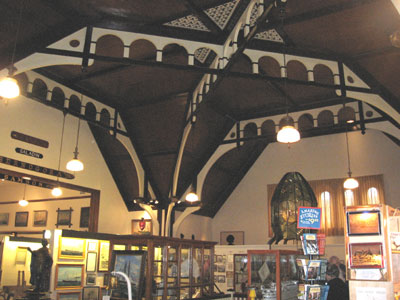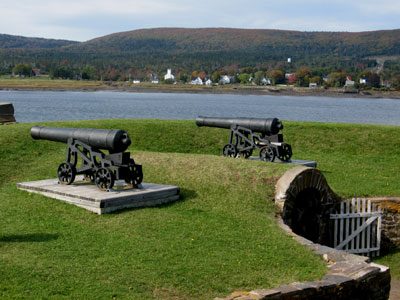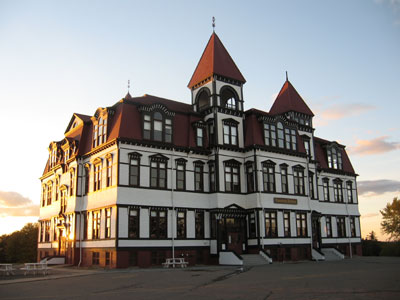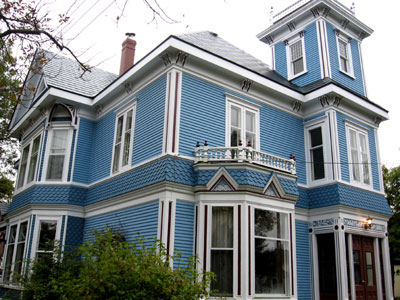One of the highlights of the Yarmouth County Museum is the lens of the Cape Forchu Lighthouse which dates back to 1908. The lens weighs approximately 3300 pounds and has 360 prisms. It was built in Paris, France, at a cost of $38,000 and was lit with kerosene. The job of a lighthouse keeper was very strenuous since a heavy tank of kerosene had to be carried up the narrow winding stairs of the lighthouse every night. The original Cape Forchu Lighthouse dating back to 1838 was replaced in 1962 at which time the lens was replaced and donated to the Yarmouth County Historical Society.
A Victorian room features a variety of historical customs and dresses as they would be worn by people about 120 years ago. Types of dress of first class, second and third class passengers were on display and speak to a time of great social divisions and class distinctions. A temporary exhibit features the silhouettes of Victorian fashions.

The Silhouttes of Victorian fashion
On the lower level of the museum various rooms display an early 1900s kitchen, a bedroom, and a nursery / toy room. These rooms provide good insight into late Victorian home life. The next room features industrial exhibits and machinery: a transmitter from a radio station, a coffee grinder and a printing press illustrate the evolution of mechanical equipment. A brass steam whistle from the Cosmos Cotton Mills is an example of industrial equipment that was used to call employees to work.

Industrial and commercial equipment
A room with various Nova Scotian wildlife scenes is followed by a forge. The blacksmith used to be one of the most important people in the village and his work environment is featured along with other implements such as a yoke (the contraption fitted around a draught animal’s necks where the plough would be attached). An early Acadian loom is testimony to the craftsmanship that existed here a few hundred years ago. A tool room features a foot-powered jig saw. Today we can hardly imagine an existence without electricity. Our ancestors were well-versed in the application of human or animal power to propel various types of equipment.

The Olympia Music Box
Several glass cases display antique glass and china collections while Mi’kmaq artifacts and arrowheads provide insight into native history and craftsmanship. Back upstairs we had a look at the antique musical instrument collection of the Yarmouth County Museum. Nadine demonstrated the Olympia Music Box, a device from 1898 that uses zinc disks for each song. A barrel with teeth plucks the various notes, propelled by a spring-loaded mechanism.
The musical instruments section was a real highlight of the museum and Nadine mentioned that usually they demonstrate three of the instruments to visitors. A Concert Roller Organ from 1902 is an example of some of the mechanical instruments that were used long ago. This device, patented in 1887, is operated by cranking the external handle. The internal bellows, tuned reeds, valves and a roller produce organ-like tones. The Square Grand Piano dates back to 1874 and a Player Organ from 1890 is also on display.

The Pianola Player Piano: little hammers strike the piano’s keys
My favourite instrument was the Pianola Player Piano, manufactured in 1902: the rectangular box is pedal-operated, and a set of tiny hammers at the back strikes the keys of a Guild “Square Grand” piano made in Boston in 1874. The Player Piano could simply be pushed up to any piano, and even a person who had never played the piano before could make beautiful music. All they had to do was to push the foot pedals up and down. Nadine played the 1920s tune “The Entertainer”, the music itself is recorded on perforated paper rolls which actually looked rather fragile to me. The foot pedals operate a bellows system that operates the little hammers that play the tune on the piano behind it. What an ingenious invention….

One of the many ship portraits
A small display area is dedicated to the Yarmouth militia, attesting to Yarmouth’s history as a military training ground during World War II. All throughout this wing of the museum numerous ships portraits depict impressive tall ships of years gone by. The ship owners would commission these paintings because once these ships were built and commissioned, they hardly ever came back to town, and in many cases the owners would never see the ships again.

The electric car, note the license plate: 990 N.S. (Nova Scotia)
We ended our tour in the new section where there is a collection of stage coaches, bicycles and other vehicles. One of the highlights in this area is the 1921 electric car of a certain Minnie L. Lovitt, who was the first female driver in Yarmouth. She must have turned a lot of heads at the time. My guided tour had come to an end and I thanked Nadine for sharing her knowledge with me and got ready for my trip along the famous Lighthouse Trail where I would experience a significant incident that helped me gain important insight into the local mentality.




